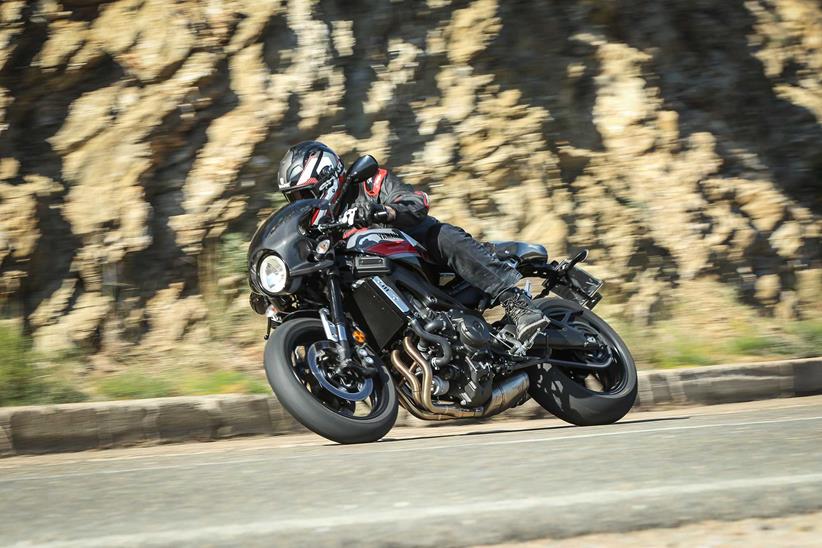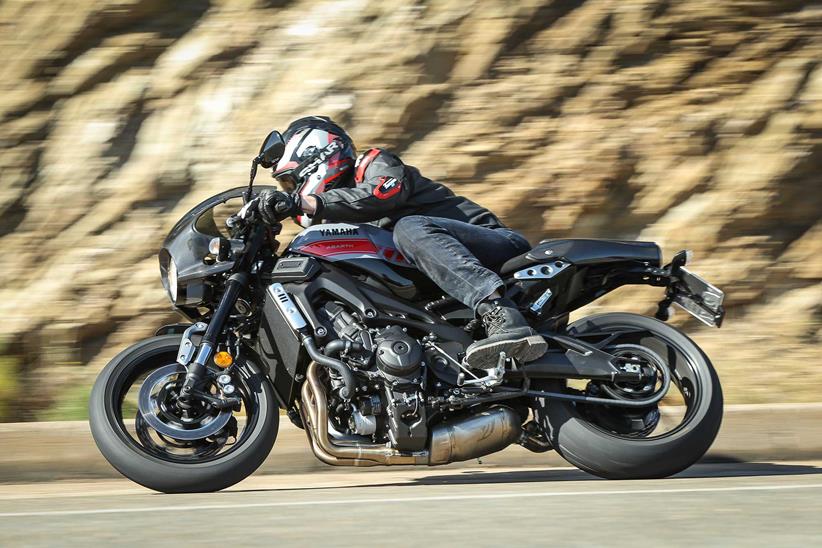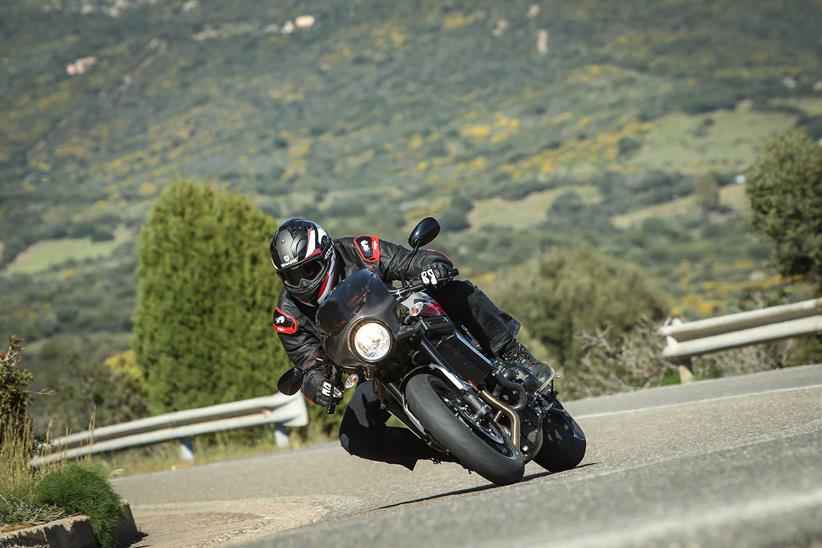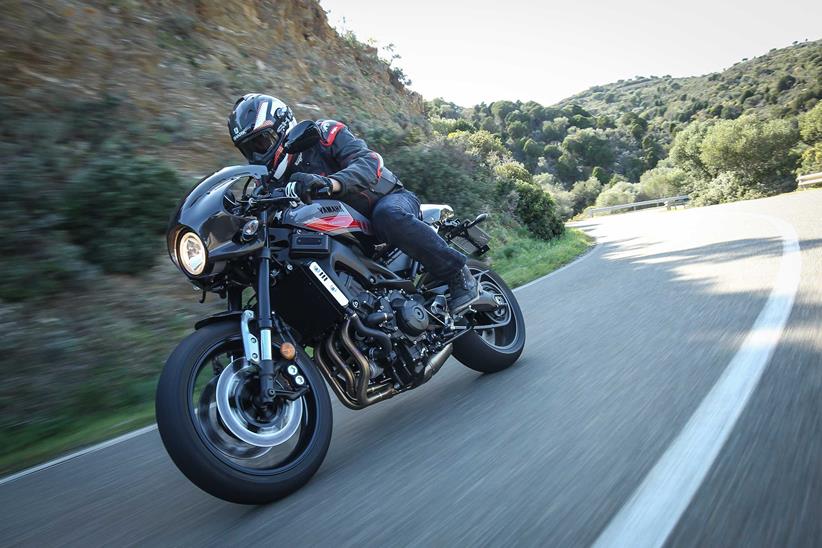Yamaha XSR900 Abarth: 'A retro streetbike success story'
Yamaha’s 2016 XSR900 is a retro streetbike success story. And deservedly so, because it takes the MT-09’s stunningly charismatic, wheelie-tastic 847cc, 115bhp inline triple motor, its die-cast ally frame, its upgraded usd forks and monoshock, and Yamaha’s suite of traction control and engine mode electronics – and endows them with a splash of vintage colour courtesy of styling and ergonomic changes.
- Related: Standard Yamaha XSR900 review on MCN
The result is a cracking motorbike: plenty fast enough, thrilling to ride, comfy, practical and stylish. It’s arguably a perfect middleweight roadster.
But the new, limited edition XSR900 Abarth takes the base XSR900 – literally, the same chassis and engine – and revises the concept into something more akin to a 1960’s café racer-cum-modern sportsbike mash-up, merely by altering the XSR900’s riding position and adding tasty cosmetic modifications. It’s a collision of new tech and old style – and has produced another classic Yamaha. But it’s a classic that won’t suit everyone.
Yamaha built the new XSR special in collaboration with the eponymous Abarth – a Fiat-owned Italian company who tune high performance, small-bore sports cars. Abarth, along with Fiat, have a long-term association with Yamaha, and both brands sponsor Yamaha’s MotoGP team.
Restricted to a total (and, promise Yamaha, a once-only) run of 695 bikes, the XSR900 Abarth is made up of a few parts from Yamaha’s accessories catalogue and existing models – such as the ace bars, Akrapovič steel and titanium exhaust, and the nose cone from the discontinued XJR1300 Racer – mixed with bespoke items specific to the Abarth – the striking ‘afterburner’ tail unit, a solo sports seat (with suede cover and red stitching) and a special grey and red paint scheme with Abarth logos on the fuel tank, front mudguard and tail.
Studying at the Abarth in the midday glare of a Sardinian launch, the differences to the base 900 stand out and give the new bike a completely different vibe. The matte grey and red paint is much prettier than it appears in the publicity photos, and careful shaping of black trim lines cleverly slims the XSR’s somewhat bulbous fuel tank. The carbon fibre nose cone combined with a unique carbon fibre ‘afterburner’ tail section (which ends in the XSR’s circular bank of red LEDs) gives the Abarth a poised, skeletal, aggressive stance. It looks like it means business.
But that’s nothing until you get on it. The Abarth’s ace bars are the same item as offered in Yamaha’s catalogue for the regular XSR900. They’re an authentic nod to the inverted cow-horn bars that riders used to reverse on their road bikes back in the 1960s, to get a low-down racer look as they bombed round the North Circular heading to the Ace Café.
Those lads must’ve had strong wrists in the 60s. This kind of handlebar is extremely low, dropping upper body-weight full and square onto forearms and wrists, and brings the Abarth’s round speedo almost up to eye-level.
Take a deep breath, fire up the smooth, free-spinning triple – no trace of a Triumph’s slightly wheezy churning here – click into first, and ease out the clutch.
The riding position declares itself immediately. There’s no escaping it; it’s radical alright. It feels cool and purposeful to ride with your hands down by the front wheel spindle, but after a few minutes you realise the only way to carry on is to change your normal weight distribution to make the Abarth tolerable. The best technique is to grip the tank with your inner thighs, sit forward against the tank (buffing the plastic tank strip with your groin in the process), tense your long-neglected abdominal muscles, and then rotate your wrists as if you were doing press-ups. It sounds uncomfortable – but, as a coping strategy, it works well and within a few miles I began to realise I could ride the Abarth this way with a lot less aching.
But then, of course, everyone knows the best way of dealing with the demands of a sports riding position is to speed up.
And speeding up is something the Abarth is very, very good at thanks to the barrage of glistening, pristine torque spun from the three cylinder’s crank like a layer of fine silk wrapped round a house brick. The engine pours it out, feeling deeply significant and yet immensely controllable at the same time. It’s a solid, road-based power figure too – 115bhp is in the Goldilocks zone of performance, neither too hot nor too dull; just fast enough to be the thrilling side of interesting.
And with more pace, the Abarth’s crazy riding position snaps into focus as, really, the best way to steer with this sort of go-motion. Tucked in, committed to the apex, chasing the vanishing point round each corner like a fleeing ghost, constantly slipping out of reach. It’s a head-down, bum-up pleasure – just like it was back in the day.
The Abarth’s suspension plays its part. It’s evolved civility and sophistication from its original purpose in the MT-09 of 2013, with alternative springing and damping to suit the XSR’s different weight balance. It suits the Abarth too, letting the bike sweep through bends in a constant stream of feedback, digging in when grip is needed front or rear, squirelling about on the brakes when a bit more feel is required. And top brakes too – all the power and control you need, when you need it.
The effect of all three – riding position, chassis ability and power delivery – combine to produce an outstandingly sporty, Sunday ride. You’d still think twice before taking the Abarth on a motorway slog, but for any other short-range chicanery, it’s hard to think of another bike that’ll do it with such panache.
But if you decide you want an XSR900 Abarth, you have two problems. The first is the price – £9999 is serious money and takes the XSR up a level against some serious rivals, such as Yamaha’s own MT-10, at just £800 more. The base model XSR900 is £8299.
Your other problem might be getting your hands on one. With 695 only worldwide, and the UK earmarked for around 100 of those, 40 Abarths have already been sold over here – so there aren’t even enough left to go round every Yamaha dealer.
Yamaha XSR900 Abarth
TECH SPEC
Engine – 847cc 12v, liquid-cooled inline triple
Bore x stroke – 78.0mm x 59.1mm
Maximum power – 115bhp @ 10,000rpm
Maximum Torque – 65 lb.ft @ 8500rpm
CHASSIS
Frame – die cast aluminium diamond
Front suspension – 41mm usd, preload and rebound damping
Rear suspension – monoshock, preload and rebound damping
Front brake – 2 x 298mm discs, 4-pot calipers, ABS
Rear brake – 245mm disc, 2-pot caliper, ABS
Front tyre – 120/70 ZR17
Rear tyre – 180/55 ZR17
DIMENSIONS
Rake/trail – 25°/103mm
Seat height – 830mm
Wheel base – 1440mm
Wet weight (claimed) – 195kg
Fuel tank – 14 litres
Price – £9999
Looking for the perfect two-wheeled companion? Visit MCN Bikes For Sale website or use MCN’s Bikes For Sale App.














